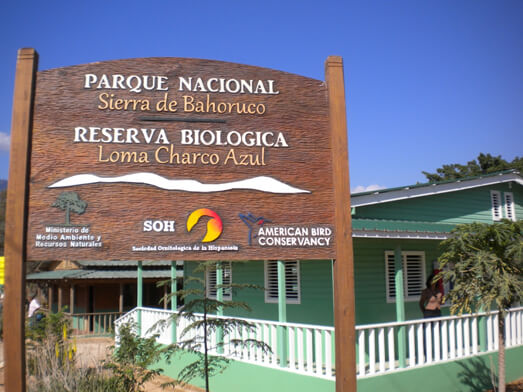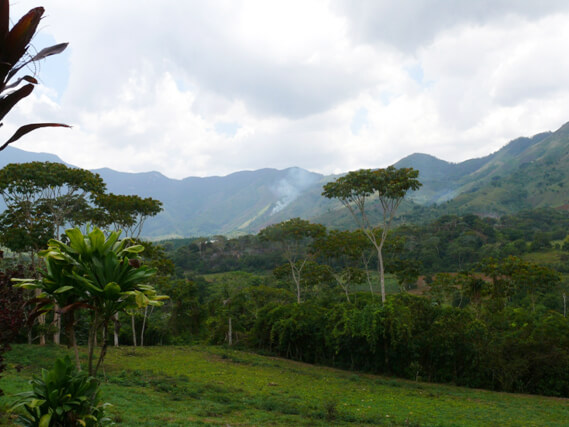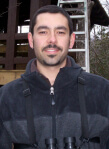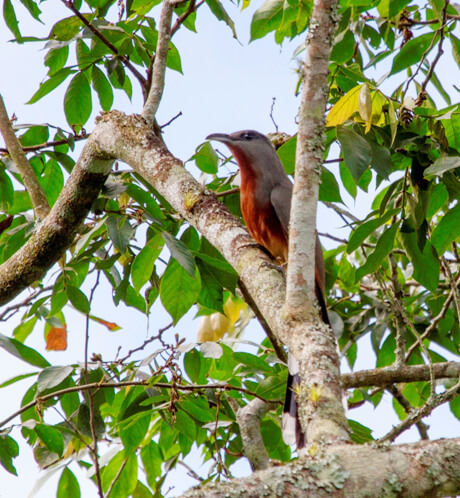Loco for Cuckoos: My Search for the Bay-breasted Cuckoo
By Andrew Rothman

The elusive Bay-breasted Cuckoo, an exceptionally rare species that I was in a race to see—and am now in a race to save. Photo by Cesar Abrill
Nearly everyone involved in bird conservation has an unseen bird that haunts them—a “ghost bird,” so to speak. My ghost bird, for years, was the Bay-breasted Cuckoo, also known as the “Cua” for its cooing call. Like most other cuckoos, this bird is exceptionally furtive, but also beautiful, with big eyes and a long, spotted tail. Unlike many other cuckoos, it is Critically Endangered, and is only found in Hispaniola, the Caribbean island shared by the Dominican Republic and Haiti.
Actually there are no Bay-breasted Cuckoos left in Haiti, where the mid-elevation forests these birds inhabit have been ravaged by excessive logging, farming, and other problems linked to poverty and human population growth. As a result, all of the world's remaining Cuas now live in the Dominican Republic, where ABC and partner groups are working to preserve the last remaining fragments of the forests that sustain it.
Symbol of Disappearing Landscapes
There are lots of rare birds in these forests, but the Cua is the one that's come to symbolize the effort to preserve these wild landscapes. That's one of reasons I've gone looking for these birds so many times over the years. But when I began my most recent trip through this part of the “DR,” the total number of Cuas I had seen stood at precisely zero.
As an International Conservation Officer at ABC, I had come to the DR to meet with representatives of the government's Ministry of the Environment, and with our partners at Sociedad Ornithologica de la Hispaniola (SOH), a Dominican NGO. We discussed ongoing efforts to protect Cua habitat by reducing illegal charcoal operations, getting more equipment to park guards, and finding ways to draw more eco-tourists to protected forests near the country's western border. I am happy to report that I saw signs of progress in and near these precious forests: for example, in the remote farm town known as Puerto Escondido, I helped inaugurate a forest-friendly Welcome and Interpretation Center.

Arriving at Sierra de Bahoruco National Park, Dominican Republic, on my quest for a Bay-breasted Cuckoo, or Cua. Photo by David Younkman, ABC
I'll describe our efforts to protect the threatened habitat of the Bay-breasted Cuckoo in more detail in a future blog. But before I do that, here's the rest of the story of my most recent attempt to see my first Bay-breasted Cuckoo.
The Quest for the Cua Begins—Again
It began just after the inauguration of that nature center, when I entered the nearby forests of the Sierra Bahoruco National Park and the Loma Charco Azul Biological Reserve. I'd once chased the echoing coo of a Cua through the tall, dry trees found here, pushing through massive clumps of Spanish moss that make these forests like something from a fairy tale. That bird disappeared before I managed to see it so I was trying again.
And failing again, despite the best efforts of two expert local guides. The long list of endemic and migratory birds that we did see in these forests was impressive, I should add: It included the colorful Hispaniolan Trogon, the lovely Le Selle Thrush, and an unexpected Western Chat-Tanager. But we neither saw nor heard a Cua. Damn.
After a few days of this, I started driving northward through the mountains in the middle of this island, accompanied by Jorge Borca, Executive Director of SOH. Our destination was the town of Rio Limpio and the protected forests that surround it—forests widely thought to be the best place to go looking for Bay-breasted Cuckoo. Getting there meant driving for 12 hours on the nasty road that forms the border between Haiti (out the driver's-side window) and the DR (out the passenger side). Before we were done we had passed through areas so thoroughly logged that it looked like the mountains had been shaved.
Finally, that evening, we reached Rio Limpio and checked into the Centro Ecoturistico de Nalga de Maco, one of two establishments used by visiting tourists. Early the next morning, I went looking for Cua in some woodlands near the oddly named Nalga Del Maco (“Butt of the Frog”) National Park. As usual, I brought along my copy of Birds of the Dominican Republic and Haiti (Latta, Rimmer, et al). As usual, the search began with no check mark or date next to the entry on Bay-breasted Cuckoo.

View of Nalga de Maco (“Butt of the Frog”) National Park, outside the town of Rio Limpio in the Dominican Republic. These mountains are one of the best remaining places to find a Cua. Photo by Andrew Rothman, ABC
Success—Times Six
I had two days left to find a Bay-breasted Cuckoo—my personal “ghost bird”—and at first it felt like the entire species had decided to toy with me. At one point, for the second time, I chased the sound of a retreating Cua through the woods without seeing the bird itself.
The next day—my last before returning to the states—I got up especially early. In parts of the woods described as “Cua haunts,” I watched the trees as Jorge played a recording of a Cua call, listening for a response.
Nothing. Still nothing. By early afternoon, after pretty much giving up hope of seeing a Bay-breasted Cuckoo on this trip, I stopped playing the recording of the Cua call and started playing a recording of an Antillean Euphonia. (Dazzling, but not a Cua).
Then, as the new recording played, I saw a bird move at the top of the trees just in front of me. Too big to be a euphonia. Just the right size for a Cua. Raising my binoculars, I saw part of a long-tailed, big-eyed something. As calmly as possible, I called to Jorge.
“Come here. What is that?”
“Si, es ella,” Jorge said. “Yup, that's her.” As we watched, the Cua crept out onto a branch so we could see her in all of her glory. Then she started issuing a series of loud, rattling “cuuaahh” calls.
I had seen my “ghost bird.” But the Bay-breasted Cuckoos weren't finished yet. In response to the “live” cooing calls, a second Cua landed in a nearby tree and responded. Seconds later, from a different spot in the same tree, two more cuckoos sounded off.
This was seriously awesome; I was seriously thrilled. I felt even better when we saw the fifth Cua on our walk back to the truck. I felt better still later that afternoon, when we drove back to the Centro and found a sixth Cua in a tree near the front door of my cabin. Hard to believe—but true.

Andrew Rothman celebrates his birding victory—sighting not one, but six Bay-breasted Cuckoos! Photo by J Brocca
After years of trying—on my fifth trip to its homeland—I had seen the bird I dreamed of seeing. But that was the easy part. The hard part will be saving it. For that, we need all the help we can get.
 Andrew Rothman, Migratory Bird Program Director at ABC, is a graduate of the University of Wisconsin-Stevens Point and holds bachelor's degrees in Biology and Wildlife Management. He founded the Rainforest Biodiversity Group in northern Costa Rica and was Executive Director of the Sarapiqui Conservation Learning Center in that country as well.
Andrew Rothman, Migratory Bird Program Director at ABC, is a graduate of the University of Wisconsin-Stevens Point and holds bachelor's degrees in Biology and Wildlife Management. He founded the Rainforest Biodiversity Group in northern Costa Rica and was Executive Director of the Sarapiqui Conservation Learning Center in that country as well.



















































